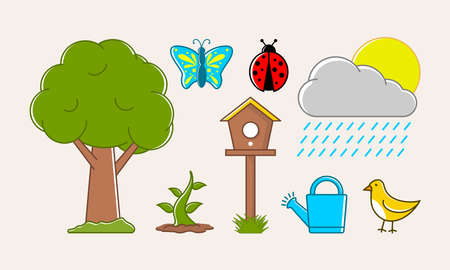Why Gardening Doesn’t Have to Be Expensive
When many people think about starting a garden, they imagine big expenses—fancy raised beds, expensive tools, and rows of pricey plants. But the truth is, gardening doesn’t have to drain your wallet. One common myth is that you need a lot of money to grow your own food or flowers. In reality, some of the most successful gardeners start small, using what they already have at home and making smart choices. Whether you live in a house with a backyard or an apartment with just a sunny window, gardening can fit any budget. By reusing containers, swapping seeds with friends, and focusing on easy-to-grow plants, anyone can get started without spending much. The joy of watching something you planted grow—whether it’s a tomato plant or a pot of herbs—is something everyone should be able to experience. So let’s bust the myth: gardening isn’t just for those with deep pockets; it’s for everyone who wants to bring a little more green into their life.
2. Planning Your Garden on a Shoestring
Starting your own garden doesn’t have to mean emptying your wallet—especially if you take the time to plan wisely. Let’s talk about how you can set yourself up for gardening success while keeping costs in check.
Tips for Choosing the Right Location
Picking the best spot in your yard or even on your apartment balcony is the first step. Aim for a location that gets at least 6 hours of sunlight per day, has good drainage, and is close to a water source. Don’t overlook small corners or unused patches—they can be transformed into productive spaces!
Location Checklist
| Consideration | Why It Matters |
|---|---|
| Sunlight | Most veggies and flowers need 6+ hours daily |
| Drainage | Avoids root rot & soggy soil issues |
| Accessibility | Easier watering and harvesting saves time & effort |
| Shelter | Protection from strong winds extends plant life |
Selecting Cost-Effective Plants Suited to Your Region
The best way to save money is by choosing plants that thrive naturally in your local climate. Native plants and regionally adapted vegetables generally require less water, fertilizer, and maintenance. Check with your local extension office or community gardening group for recommendations that fit your USDA Hardiness Zone.
Budget-Friendly Plant Picks by Region (Sample)
| Region | Veggies/Herbs | Flowers |
|---|---|---|
| Northeast | Kale, Lettuce, Chives | Black-eyed Susan, Coneflower |
| Southeast | Okra, Sweet Potatoes, Basil | Zinnia, Marigold |
| Midwest | Green Beans, Spinach, Mint | Sunflower, Coreopsis |
| West Coast | Tomatoes, Peas, Rosemary | Poppies, California Lilac |
| Southwest | Pepper, Squash, Cilantro | Lantana, Penstemon |
Setting a Realistic Budget for Your Garden Project
You don’t need fancy tools or expensive raised beds to get started—just a smart budget! Write down all expected expenses: seeds/plants, soil amendments, basic tools, and any containers or supports you might need. Be sure to leave a little wiggle room for unexpected finds at garage sales or thrift stores. Sticking to a budget will help you prioritize essentials and avoid impulse buys.
Sample Starter Budget Table (Estimated)
| Item | Bargain Price Estimate ($) |
|---|---|
| Seeds/Starter Plants | $10-20 |
| Soil/Compost (Bagged or DIY) | $10-25 |
| Basic Tools (Trowel, Gloves) | $8-15 (used/new) |
| Pots/Containers (Recycled OK!) | $0-10+ |
| Total Estimated Startup Cost: | $28-70+ |
With these planning tips and a little creativity, you’ll be well on your way to growing a beautiful and productive garden without breaking the bank.

3. Smart Shopping: Tools and Supplies on a Dime
Let’s be honest—gardening can get expensive fast if you’re not careful. But before you splurge at the big box store, take a step back and think creatively about where to find what you need. Thrift stores are hidden gems for gently used tools, sturdy pots, and even old kitchen utensils that can double as garden markers or mini trowels. Take a stroll down the aisles with an open mind; you’d be surprised how many “junk” items have a second life in the garden.
Don’t forget about local community swaps or online groups like Facebook Marketplace, Freecycle, or your neighborhood Buy Nothing group. These resources are perfect for exchanging plants, seeds, and supplies with fellow gardeners who might have exactly what you need—no money required! Many communities also host spring or fall plant swaps where you can trade extras from your own yard for something new to try.
Sometimes the best gardening supplies are already sitting around your house. Got old buckets? They make excellent planters after poking a few drainage holes in the bottom. Egg cartons work great for starting seeds, and empty milk jugs can be transformed into watering cans or mini greenhouses. Even broken household items—think chipped mugs or cracked storage bins—can find a new purpose outside among your veggies or flowers.
Getting thrifty with your shopping isn’t just about saving cash—it’s also about building a resourceful, sustainable gardening routine. With a little imagination and some neighborly connections, you’ll be amazed at how far your dollar (or zero dollars!) can stretch.
DIY Solutions for Garden Essentials
If you’re looking to stretch your gardening dollars, one of the best ways is to embrace a do-it-yourself attitude. Making your own compost, garden beds, and plant markers not only saves money but also reduces waste and adds a personal touch to your outdoor space. Let’s dig into some creative, budget-friendly ideas using recycled or inexpensive materials.
Composting: Turn Kitchen Scraps Into Black Gold
Why spend on commercial fertilizers when you can create nutrient-rich compost right at home? All you need are everyday kitchen scraps and yard waste. Use a simple bin or even an old storage container with some holes drilled in for airflow. Layer food scraps (like veggie peels and coffee grounds) with dry materials (leaves, cardboard, shredded newspaper), turn it occasionally, and let nature do the work. In a few months, you’ll have homemade compost perfect for nourishing your plants.
Budget-Friendly Garden Beds
Raised beds are great for controlling soil quality but buying new lumber can add up fast. Instead, consider these alternatives:
| Material | Where to Find | Tips for Use |
|---|---|---|
| Pallets | Local stores, Craigslist, Facebook Marketplace | Look for heat-treated pallets (marked “HT”), avoid chemically treated ones; line with landscape fabric if needed. |
| Cinder Blocks | Construction sites, hardware stores, recycling centers | Arrange in any shape; fill holes with soil to plant herbs or flowers. |
| Repurposed Bricks/Stones | Your own yard, demolition sites | Create rustic borders; check permission before salvaging from public spaces. |
| Upcycled Wood Planks | Old furniture, scrap yards | Treat wood with natural sealant to prolong life outdoors. |
Homemade Plant Markers: Practical & Fun
No need to buy fancy plant tags when you can get creative with items already around your house. Try these easy ideas:
- Popsicle Sticks: Write plant names with a permanent marker.
- Wine Corks: Attach corks to skewers or chopsticks and label them.
- Flat Stones: Paint or write directly on smooth rocks for a natural look.
- Spoon Handles: Bend old metal spoons and engrave or paint the names on the handle.
The Family Touch: Make It a Group Project!
These DIY solutions are not just cost-effective—they’re also a great opportunity for family bonding. Get kids involved in painting markers or assembling raised beds. Not only will you save money, but you’ll create lasting memories together in your home garden.
5. Buying Seeds and Plants the Frugal Way
When you’re gardening on a budget, every dollar counts—especially when it comes to buying seeds and plants. The good news is that there are plenty of creative ways to save money without sacrificing your garden’s potential. Here are some tried-and-true strategies for sourcing affordable seeds, swapping with neighbors, and even growing from kitchen scraps.
Shop Smart for Seeds
Big box stores and local nurseries often put last season’s seed packets on sale, sometimes for as little as a quarter each. Don’t worry about the “packed for” date—most seeds are viable for several years if stored properly. You can also check online marketplaces, where gardeners often sell or trade surplus seeds at a fraction of the retail price. Look for seed libraries at your local public library or community center; these programs let you borrow seeds for free, with the hope that you’ll return some after your harvest.
Swap with Friends and Neighbors
Seed swaps are a fun, social way to diversify your garden without spending extra money. Reach out to friends, neighbors, or local gardening groups—chances are someone has extra tomato or zinnia seeds they’d love to trade. Many communities host annual seed swap events in early spring. Not only will you get new varieties to try, but you’ll also connect with fellow gardeners who can offer advice and support.
Grow from Kitchen Scraps
You might be surprised by how many plants you can grow from everyday kitchen leftovers. Green onions, lettuce, celery, potatoes, sweet potatoes, and even some herbs like basil can all be regrown from scraps. Simply place the root ends in water until they sprout, then transplant them into soil. This method is practically free and a great way to teach kids about plant cycles right at home.
Tips for Success
- Store unused seeds in an airtight container in a cool, dark place to extend their lifespan.
- If participating in a swap, label your seeds clearly and bring extras to share.
- Experiment with regrowing different kitchen scraps—you might discover a new favorite!
Remember:
Gardening doesn’t have to be expensive. With a little creativity and community spirit, you can fill your garden beds without emptying your wallet—and maybe make some new friends along the way.
Ongoing Care Without Ongoing Expenses
Once your budget-friendly garden is up and running, keeping it healthy shouldn’t mean shelling out more cash. There are plenty of smart, affordable ways to maintain your plants without stretching your wallet.
Low-Cost Watering Solutions
Water bills can sneak up fast, but you have options. Consider setting up a rain barrel to collect free water for your plants. Early morning or evening watering helps reduce evaporation, meaning less water waste. Mulching around your plants with grass clippings or leaves you already have at home also helps retain moisture in the soil, cutting down on how often you need to water.
DIY Fertilizing Tricks
You don’t need fancy store-bought fertilizers—your kitchen scraps can work wonders. Start a compost pile with vegetable peels, coffee grounds, and eggshells. Even “compost tea” made by soaking finished compost in water can give your plants a gentle boost. If you have neighbors who keep chickens or rabbits, ask about sharing manure for an all-natural fertilizer swap.
Pest Control—The Frugal Way
Skip the expensive sprays and look to nature. Encourage ladybugs and birds that eat pests by planting native flowers and providing small water sources. Hand-picking bugs or using homemade sprays (like diluted dish soap) can keep infestations in check. Crop rotation and interplanting herbs like basil and marigold also help confuse pests and protect your harvest.
The Power of Local Gardening Groups
One of the best resources is right in your community. Join local gardening clubs or online neighborhood groups—many gardeners love to trade seeds, cuttings, tools, and advice. You might find a free seed swap event at your local library or get tips about plant sales from someone nearby. Sharing resources doesn’t just save money; it builds friendships and strengthens your connection to the community.
Keep Growing Without Overspending
With a little creativity, ongoing care for your garden can remain affordable—and even fun! Embrace these low-cost strategies and lean on fellow gardeners to make your backyard bounty thrive year after year.

